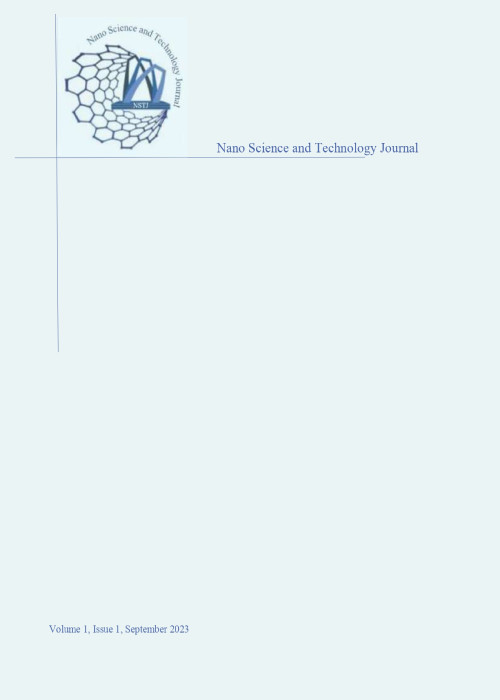فهرست مطالب

Nano Science and Technology Journal
Volume:1 Issue: 1, Summer 2023
- تاریخ انتشار: 1402/06/31
- تعداد عناوین: 6
-
Pages 1-16This paper presents the synthesis of a novel magnetically heterogeneous nanocatalyst, MNPs-DTPA-Cu, which is composed of Fe3O4 nanoparticles modified with a copper complex of pentetic acid or diethylenetriaminepentaacetic acid (DTPA). The synthesis process involves a simple and cost-effective two-step procedure using readily available precursors. The structure of these nanoparticles was characterized using several techniques, including SEM, TGA, XRD, FTIR, VSM, EDS. These techniques provided valuable insights into the composition and properties of the nanoparticles. The catalytic performance of this novel material has been thoroughly investigated in the synthesis of benzimidazole derivatives through a one-pot condensation reaction of aldehydes and o-phenylenediamine. Remarkably, the reaction proceeded under solvent-free classical heating conditions, resulting in good to excellent yields of the desired products. The present catalytic system possesses several notable features, including shorter reaction time, mild reaction conditions, simplicity, and non-toxicity. Additionally, the catalyst can be easily recovered using an external magnet and can be reused up to six consecutive times without any significant loss in catalytic efficiency.Keywords: Benzimidazole, Magnetic nanoparticles, pentetic acid-copper complex, Heterogeneous catalyst, Solvent-free
-
Pages 17-22NiCuZn ferrite is the most important magnetic materials used for the manufacturing of multilayer chip inductors due to its low sintering temperature (<950°C) and good electromagnetic properties. In this study, the Ni0.50-xCuxZn0.5Fe2O4 nanopowders with different Cu contents (x=0.15, 0.20 and 0.25) were prepared through the nitrate-citrate auto-combustion route. The prepared powders were calcined, compacted and sintered at 900 °C for 4 h. The structural and magnetic properties were investigated as a function of Cu content. X-ray diffraction patterns showed the formation of cubic spinel structure for all samples. A significant increase in density from 4.66 to 4.82 g/cm3 were observed with increasing Cu content. The microstructural evaluations revealed that Cu can affect the densification and porosity of the samples. The electromagnetic results revealed that the magnetic permeability increased with Cu content and the highest value of 161 was obtained at x = 0.25.Keywords: Nanocrystalline materials, ferrite, Electroceramics, Initial permeability
-
Pages 23-30The linearized quantum hydrodynamic model (QHD) is employed to investigate the dispersion relation of electrostatic waves propagating through Single Walled Carbon Nanotubes (SWCN) subjected to an axial magnetic field. Previously, we theoretically computed the conditions for exciting quantum electrostatic modes in a CNT filled with electrons and exposed to an axial magnetic field, utilizing wavelengths spanning the microwave to visible spectrum range [1, 2]. In this paper, we present the dispersion relations, unveiling the magnetic field's influence on the excitation of quantum acoustical and optical waves. We establish that weak magnetic fields hinder the propagation of quantum acoustical waves, while strong magnetic fields permit it. Additionally, the excitation of quantum optical waves across all magnetic field strengths requires wavelengths from the microwave to visible spectrum. Lastly, we depict the dispersion relations of acoustical and optical modes as a logarithmic function of the magnetic field’s base 10. Through a comparative analysis using two models, we reveal intriguing disparities between these two modes. This study might provide a platform to create new finite transverse cross section quantum magnetized plasmas and to devise nanometer dusty plasmas based on the metallic carbon nanotubes in the absence of either a drift or a thermal electronic velocity and their existence could be experimentally examined.Keywords: Electrostatic waves, Quantum Hydrodynamics model, Carbon Nanotube, Axial magnetic field
-
Pages 31-37The purpose of this article is to fabricate Cu-Ni nanoparticles of different sizes to investigate the morphology and structural properties of these nanoparticles. Cu-Ni nanoparticles with different nickel layer thicknesses were deposited with capacitive capacitance using a radio frequency plasma enhanced chemical vapor deposition (RF-PECVD) system. The 15 nm thick Ni films have a phase shift of about 25 nm compared to the other films, indicating that the films are firstly very smooth and secondly capable of phase change. Cu NPs without Ni, Cu NPs with 5 nm of Ni and 10 nm of Ni have cavity coverage of less than 5% and layer content of about 90% and 95% which are monolayer heights. Increasing the thickness of nickel affects the index of absorption coefficient of Cu-Ni thin films.Keywords: Ni layer thicknesses, Morphology, Bearing Area, Absorption coefficient
-
Pages 38-48The present study aimed to investigate the feasibility of using the novel type of PMMA/TiO2 nanocomposite film as a highly efficient visible light photocatalyst for photocatalytic degradation of amoxicillin (AMOX) as a model pollutant from aqueous solution and determining its removal efficiency. The prepared PMMA/TiO2 nanocomposite which was prepared by ionic liquid based microemulsion with (0.01 wt.%) of TiO2 content exhibited high photocatalytic activity due to increase in the generated hydroxyl radicals during the mineralization under visible light illumination. The effect of pH as an operating factor was evaluated and it was found that the pH of 7 is optimal pH to achieve the high photocatalytic efficiency. Also we tried to understand the reasons behind this performance of nanocomposites by means of generated hydroxyl radicals. Finally we introduced a survey of the behaviour of this novel PMMA/TiO2 nanocomposite with low loading amount of TiO2 nanoparticles.Keywords: Nanocomposite, Visible light active, photocatalytic activity, Amoxicillin
-
Synthesis, characterization and photocatalytic properties investigation of CuFe2O4/CdO nanocompositePages 49-55In this article, copper ferrite (CuFe2O4) nanoparticles were synthesized by ultrasonic method without using surfactant. Cadmium oxide (CdO) nanoparticles were also synthesized without capping agent. After that, copper ferrite/ cadmium oxide nanocomposite was synthesized via ultrasonic method. Structural properties of synthesized CuFe2O4 and CdO nanoparticles and CuFe2O4/ CdO nanocomposite were studied using X-ray diffraction (XRD). The morphology of nanostructures was investigated by field emission scanning electron microscope (FESEM). The magnetic properties and hysteresis loop of the produced nanomaterials were investigated using a vibrating sample magnetometer (VSM). Finally, the photocatalytic properties of copper ferrite/cadmium oxide nanocomposite were studied using red acid and blue acid azo dyes.Keywords: Nanocomposite, Photocatalytic, Ultrasonic

